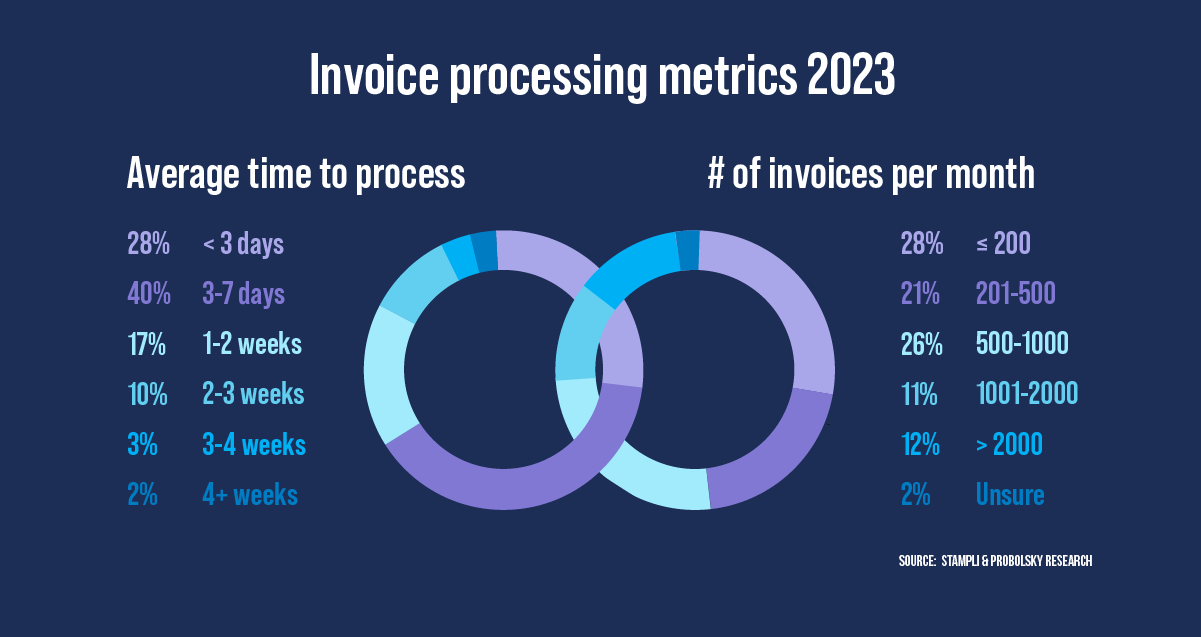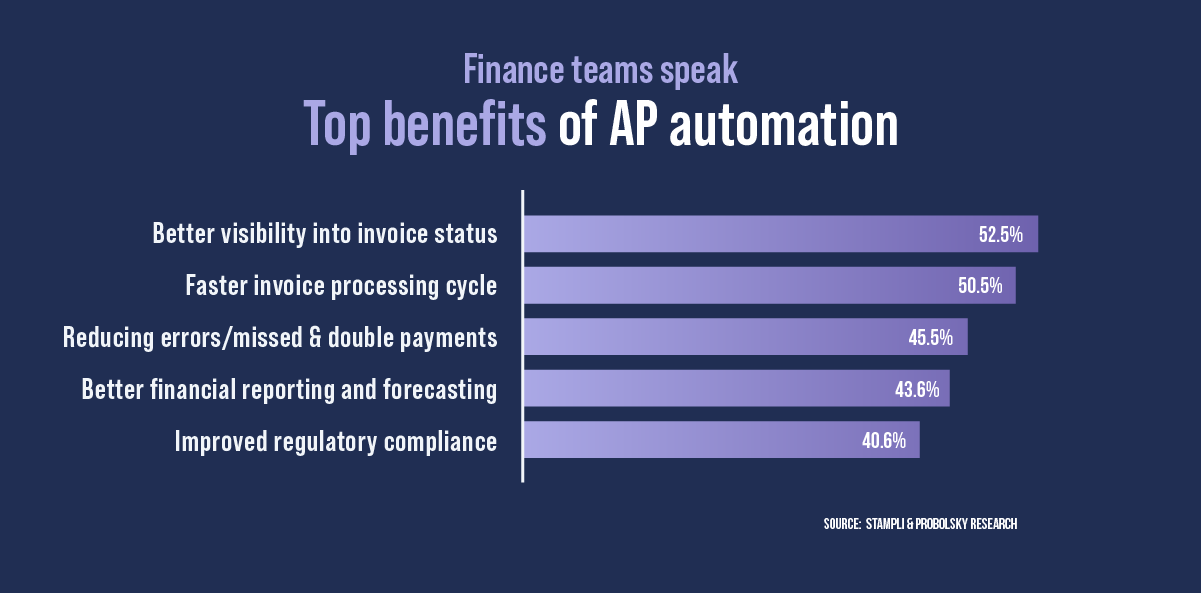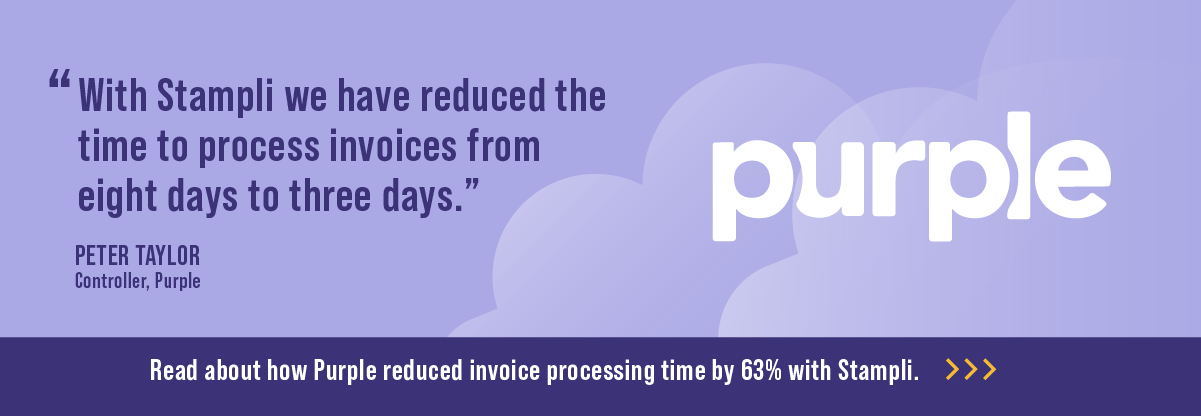How to improve invoice processing cycle time with AP automation

It’s hard to overstate the importance of measuring invoice processing cycle time.
Peter Drucker is often quoted as saying, “You can’t manage what you can’t measure.” If you don’t know how fast your accounts payable department is processing invoices, you also don’t know how fast they are paying suppliers or how fast your business is spending money.
You may think of invoice processing cycle time as a good way to measure your AP department’s performance, but did you know it’s also a key metric for strategic financial management?
Calculating this straightforward metric — the time it takes an AP team to process an invoice from receipt to payment — can help you optimize your AP workflows and make informed working capital decisions.
However, many businesses fail to grasp this advantage because they face two obstacles: 1) they don’t have an efficient and accurate way to measure invoice processing times, and 2) they are using manual processes and digital solutions that impede their ability to optimize AP workflows.
In this article, you’ll learn how financial process automation gives you visibility into accurate and actionable invoice processing metrics and lets you optimize and control AP processes. We’ll discuss:
- What is invoice processing time, and why it’s important.
- Top invoice processing metrics to track.
- How to accurately measure invoice processing cycle time.
- Ideal invoice processing times and how to manage them.
- Strategies to improve invoice processing cycle control.
After reading this guide, you’ll better understand the invoice processing cycle and have a toolkit you can use to improve accounts payable performance and make informed strategic financial decisions.
Let’s jump in.
Benefits of measuring invoice cycle time
Calculating and monitoring the invoice processing cycle time enables finance leaders to understand and control how long the company takes to process and pay vendor invoices. Understanding and leveraging this important metric has several significant benefits for your business.
Smarter cash management
Usually, if your business has extra money, it tries to give that money a job. You can make short-term investments, pay down bills or debt, pay invoices early to earn early payment discounts, invest in business growth, or just put it in a big pile and swim around in it like Scrooge McDuck.
The important thing is to know when your business has extra money. If you don’t have visibility into how fast you’re paying vendors, you need to play it safe and keep enough cash to ensure your business can cover its bills.
When you know your invoice processing lifecycle time, you have a better idea of your days payable outstanding and future cash flow, so you can put that idle cash to work.
Save time and money
Measuring invoice processing cycle times lets you understand and improve how well your AP team is performing. At a high level, you can see at a glance how quickly your business is paying its suppliers.
You can also combine invoice processing time with other metrics to drill down into specific workflows and identify bottlenecks and broken processes. For example, a high invoice processing time and a high approval-to-payment time could indicate a need for improvement in your payment process — like maybe moving from paper checks to electronic transfers.
Make vendors happy
Everyone likes to get paid on time. Nobody likes to make collection calls. By monitoring your invoice processing cycle time, you can ensure your business is making timely payments to its suppliers, and you can jump in and move things along if it’s falling behind. Paying vendors on time means they’ll be much more likely to offer preferential treatment like better credit terms and discounts and much less likely to cancel a shipment for nonpayment.
Informed strategic decision-making (with use case)
Forewarned is forearmed. Knowing your invoice payment cycle times means you can anticipate cash flow requirements, better manage AP team performance, improve the accuracy of your budgets and forecasts, and strategically manage vendor relationships. Putting this all together means your financial leadership can be more about being strategic and less about putting out fires.
Use case: fixing late vendor payments
Jeff is the finance director for a medium-sized manufacturer. One of their largest suppliers has complained to Jeff’s CEO that the company is always late paying invoices.
Jeff measures the supplier’s invoice processing time, which shows that his AP team takes an average of 30 days to process the invoices from receipt to payment. He drills down further and learns that the receipt-to-approval turnaround time is 20 days, much longer than his team’s average of 3 days.
Upon investigation, Jeff learns that the supplier sends very long paper invoices with hundreds of line items. It takes his AP team a long time to manually enter and code those invoices and match them to the purchase orders (which are also very long). Because they’re human, they get tired and frustrated and make mistakes, which results in the approvers constantly sending invoices back for clarification. As a result, Jeff’s company is often late paying the supplier.
Jeff takes a strategic approach to the problem. First, he contacts the supplier and asks if they could send digital invoices, and they agree. Next, he invests in a financial automation solution that automates invoice data entry and coding. After Jeff made these two changes, the receipt-to-approval time decreased to a more manageable 4 days. He could now pay the supplier on time, making them (and the CEO) happy.
More importantly, automating invoice capture, data entry, and matching frees Jeff and his team to focus on higher-value, strategic tasks. They build on their success by regularly monitoring invoice processing times and using the insights gained to strategically optimize invoice processing.
Top 5 invoice processing performance metrics
While invoice processing cycle time, the time it takes to process an invoice from receipt to payment, is the key AP metric, there are 5 other KPIs you should understand:
1. Days payable outstanding
Days payable outstanding (DPO), or accounts payable days, measures the average time it takes an organization to pay its invoices over a specific accounting period. While invoice processing cycle time provides a snapshot of AP performance, DPO tracks longer-term trends. For example, by measuring the DPO each month, you can identify cyclical trends in invoice processing times. This lets you anticipate busy months and adjust your AP resources accordingly.
2. Invoice receipt to approval time
Invoice receipt to approval time measures how long it takes a business to capture, code, verify, and approve an invoice. Knowing this metric helps you zero in on bottlenecks in the invoice process. In our example, by identifying a very high invoice receipt to approval time, Jeff could narrow in on manual paper-based processes that were slowing down invoice processing.
3. Invoice approval to payment time
Invoice approval to payment time measures how long it takes your business to pay an invoice once it has been approved. It gives you good insights into your payment processes and helps you identify inefficiencies. For example, a company may notice that their invoice approval to payment time is very high for certain suppliers. They investigate and find that they are paying those suppliers with paper checks rather than electronic funds transfer (EFT). By moving these suppliers to EFT payments, they can reduce their invoice approval to payment time and DPO.
4. Number of invoices processed per full-time equivalent (FTE)
The number of invoices processed per FTE measures how many invoices an average AP team member is processing. Knowing this metric helps you assess your AP team’s performance, plus it lets you see the impact of productivity improvements like AP automation.
Measured over time, the number of invoices processed per FTE is also a good measure of your AP team’s capacity. For example, say an AP team with 4 FTEs is processing 100 invoices per FTE per month. That means the AP department can process 400 invoices per month. If the company is receiving 500 invoices per month, the team is likely at overcapacity and may be falling behind — which will be revealed by an upward trend in DPO and invoice processing cycle time.
5. Average cost to process an invoice
Calculating the average cost to process an invoice helps you understand the true cost of invoice processing to your organization. It shows you the direct invoice processing costs, like labor, file storage, and IT costs. It also reflects indirect invoice processing costs like late payment fees, fraud, errors, and missed discounts.
Understanding the average cost to process an invoice lets you calculate the ROI of improving your invoice processing efficiency. In our example, by implementing an invoice processing automation platform, Jeff was able to lower the average cost of processing an invoice. He reduced labor costs by eliminating labor-intensive manual processes and reduced indirect costs by shortening the invoice processing cycle time and avoiding late payment fees from suppliers.
Now that we know these metrics and why it’s important to understand them, let’s talk about how you measure them.
How to measure invoice processing cycle time metrics
On the surface, measuring invoice processing times is a straightforward job: just count the days from the time your AP team receives an invoice to the time they pay it. There are two ways you can do this. You can measure invoice processing times manually or use a software solution with tracking and reporting features.
Manually calculating invoice processing times
As we said, to manually calculate invoice processing times, you count the days to process an invoice from receipt to payment. An easy way to do this is to enter the receipt and payment dates for every invoice into an Excel spreadsheet. Then, you can use formulas to calculate the processing times for each invoice and the average invoice processing time for your AP team.
The downside of manual calculations is that they’re slow. If your AP team is managing a large volume of invoices, tracking and entering receipts and payment dates can take a very long time. Plus, there’s also the potential for errors that could throw off your measurements.
Tracking invoice processing times with financial automation software
Many financial automation platforms track and report invoice processing times and other AP metrics. Leading solutions like Stampli provide real-time reporting and analytics and feature live AP dashboards that let you check key metrics and trends at a glance.
By providing accurate and actionable invoice processing metrics, financial automation platforms let you quickly make informed decisions and optimize your AP workflows. For example, one Stampli customer said having access to real-time reports increased accountability by helping her company identify who was causing bottlenecks in invoice processing:
“It holds individuals throughout our company accountable for their reviewing and approving invoices. We can easily manage correspondence. Track invoices that are past due. Pull everything into one nice neat report to review with our users.
“The reports make a great resource to share with GMs, that can quickly review what vendors or invoices that may be causing holds for our company.”
Armed with timely and accurate invoice processing metrics, you can make informed decisions to improve your AP team’s performance, better manage cash flow, and realize better returns on your money.
Use accounts payable metrics to benchmark invoice processing time
To assess and improve your AP team’s performance, you can compare your invoice processing cycle time and other metrics against industry standards and competitors.
Industry standards for invoice processing time
Benchmarking your invoice performance cycle time against industry standards can help you set a target for improving invoice processes.
According to the American Productivity & Quality Center (APQC), the world’s leading benchmarking authority, the average invoice processing cycle time for top organizations is 2.8 days. The APQC says top organizations achieve this benchmark through AP automation, maintaining a practice of accountability and process ownership in AP teams, and continuously seeking areas of improvement in their processes.
In the same report, the APQC says the invoice processing cycle for the least efficient organizations is 7 days or more.
Note that although it’s a valuable AP statistic, the APQC’s benchmark is for all organizations across the US. The invoice processing benchmark for some industries may be higher. You should look for benchmarks specific to your organization to refine your targets. One good way to do that is to look at your competitors.
Analyze competitor invoice processing times
Studying invoice processing times for organizations in your sector can help you find a more relevant metric for your organization. You can further refine your results by looking at similar-sized companies.
For example, in 2023, Stampli and Probolski Research surveyed financial leaders at medium and large businesses in the financial services, construction, manufacturing, retail, and other industries. Just under three-quarters (67.7%) reported that their invoice processing time was under one week — approximately half (51.6%) process over 500 invoices per month.

Once you set invoice processing benchmarks, you can take steps to gain better control over invoice processing. Gaining better control pays dividends beyond more efficient processing and cost savings — it also enables you to proactively manage cash flow by controlling when you pay suppliers.
The ideal invoice processing cycle time for cash flow management
The primary benefit of improving invoice processing efficiency and reducing invoice processing cycle times is that it lets your organization pay its vendors faster. However, it also gives you more control over when you pay vendors — which is an important strategic advantage.
Understanding the pros and cons of shorter and longer cycles is key to finding the ideal processing cycle time.
Shorter invoice processing times
Paying suppliers faster has some significant benefits. It improves supplier relationships, helps your business avoid late payment fees, and lets you take advantage of early payment discounts. Strengthening supplier relationships also gives your organization a better chance of negotiating better payment terms or discounts.
Longer invoice processing times
Strategically delaying supplier payments can also be beneficial. It lets your organization hold on to cash longer, improving cash flow. However, it can strain vendor relationships, and vendors may respond by withdrawing favorable credit terms or refusing to make deliveries. It’s better to leverage positive supplier relationships and negotiate better credit terms to give your organization more flexibility.
Striking the right balance
The ideal balance optimizes cash flow, operational efficiency, and supplier relationships. Your organization’s ideal invoice processing cycle depends on several factors, such as revenue, creditworthiness, inventory turnover, and others. For example, a good strategy is to align your accounts receivable with accounts payable to ensure your business has enough cash on hand to make its obligations. If your days sales outstanding (DSO), the time it takes your company to get paid, is very high, you should consider taking longer to pay vendors to ensure a healthy cash balance.
Strategies to improve invoice processing times
You can use some strategies to streamline and optimize invoice processing and gain more control over invoice processing times.
Automate accounts payable
Implementing a financial automation system is one of the most effective ways to optimize invoice processing times. AP automation eliminates manual tasks like invoice capture, GL coding, and matching, automatically routes invoices to approvers, and streamlines payment processing. It reduces errors and the risk of fraud by enforcing internal controls and centralizing communications. It also provides accurate, real-time data and analytics, giving you total visibility and control over invoice processing time.
Leading financial automation platforms like Stampli integrate with ERPs, accounting software, and other business systems to synchronize data across the organization. By providing live access to purchase order details and shipping receipts, integration expedites invoice coding, 3-way matching, and approvals.

Manually processing invoices with inadequate, poorly integrated digital solutions results in long invoice processing times and late or missed payments. Stampli goes beyond basic process automation to provide true process optimization and total control over invoice processing.
“In an era where time is of the essence, and efficiency is paramount, Stampli stands out as a beacon of simplicity and effectiveness,” says one Stampli customer. “One of the standout features of Stampli is its seamless integration with existing accounting systems. Regardless of whether your organization utilizes QuickBooks, NetSuite, or another platform, Stampli seamlessly integrates, eliminating the need for tedious manual data entry and ensuring data accuracy.
“Navigating through invoices and approvals is a breeze with Stampli. The platform’s intelligent automation capabilities streamline the entire invoice approval process, allowing for swift and efficient processing. With Stampli, gone are the days of lost invoices and delayed approvals – everything is centralized and easily accessible, enhancing transparency and accountability within the organization.
“Stampli redefines invoice management, making tedious tasks a thing of the past.”
Improve internal controls and standardize AP processes
Establish clear, consistent controls and procedures for invoice processing. For example, you can streamline approvals by using a rules-based approach to routing invoices. By setting rules such as requiring senior management to sign off on high-value invoices, you can ensure they are routed to the right approver.
Financial automation systems that feature customizable approval routing can automate the approval process; however, their rules-based routing processes are often inflexible. Changing routing rules when business processes change can require expensive IT rework. Stampli offers customers a choice of fixed or dynamic approval workflows. Dynamic workflows leverage AI technology to automatically adapt when your business processes change, with no rework required.
One customer says, “Stampli solved our issue of not getting each invoice approved by a manager. Within the first month we had caught several invoices that should not have been paid whereas before Stampli they could have been paid without proper approvals.
“Stampli allowed us to move our AP process paperless in a matter of 1 day! It was simple to implement (literally 10 seconds to connect it to NetSuite, plus a couple of minutes for it to download the vendor and item lists), and it is simple to use (as noted by the majority of the approvers).”
Collaborate with suppliers to improve processing times
Engage suppliers to help make invoice processing easier and more efficient. For example, asking suppliers who send paper invoices to switch to digital invoices can significantly reduce invoice processing times.
Some financial automation platforms feature self-serve vendor portals that let vendors submit invoices directly, ask and answer questions, update their documents, and check payment status. Stampli’s Advanced Vendor Management solution ensures vendor documentation and details are kept current, preventing processing and payment delays. It automates vendor onboarding and centralizes all communications between vendors and your AP team.
“Stampli is a top-tier A/P automation platform,” says a customer in the construction industry. “It contains a plethora of technology-packed features to help cut back low-value tasks like data entry and invoice approval routing. In addition, it features a great vendor management system for subcontractor documents that makes vendor management for construction companies a breeze. It is intuitive and easy to implement and use by a wide variety of technology proficiency levels.
“Stampli is creating an efficient approval process, better vendor management, and better invoice entries for the payables team.”
Get total control of invoice processing time with Stampli
Finance teams face increasing demands to manage cash flow and liquidity more effectively. Stampli offers the resources and support to help finance leaders optimize invoice processing workflows and improve working capital management.
Case study: Purple reduces invoice processing times and strengthens internal controls
Utah-based Purple is the company that started the mattress revolution in 2013. Known for creating “The World’s First No Pressure Mattress,” Purple continues to delight tens of thousands of customers.
Purple’s spectacular growth came with spectacular AP problems. With over 1350 vendors, Purple’s AP team was overwhelmed. “Our AP inbox was like a giant black hole,” says controller Peter Taylor. “We would request that our vendors send invoices to a Purple accounts payable email inbox that was managed by an AP clerk and an AP supervisor.
“We did weekly pay runs that took our two resources nearly two full days to draft the list of vendors we needed to pay that week as they manually searched through Outlook to determine which bills needed to be paid.”
Purple needed a way to take full control of the invoice lifecycle and improve communications so they could better manage their invoice processes and reduce the backlog. After unsuccessfully testing Concur Invoice, Purple chose Stampli.
They implemented Stampli and spent two weeks testing its capabilities before going live. The positive impact on Purple’s invoice processes was significant. “We’re definitely seeing a reduction in OPEX with Stampli. Not only have we reduced invoice backlog by at least 50% in the first few months, but we’ve eliminated paying duplicate invoices. That’s something that seemed to happen more often than not,” says Peter.

With Stampli, Purple documents 100% of their invoices and has achieved a 63% reduction in invoice processing time. But Peter says the biggest value of implementing Stampli was how it freed his team to focus on strategic tasks:
“The workforce productivity optimization has been, in my mind, the best because I like my team doing things that add value to our business, like expanding vendor relationships, and delivering goodwill via our modernized AP workflow to the rest of our organization.”
Take control of your payables today
Stampli is the smartest and fastest financial automation platform and the best way to get control and visibility over the invoice processing cycle. Created by AP professionals for AP professionals, Stampli brings the capability, knowledge, and experience to help you maximize AP processing efficiency, access accurate, actionable insights, and turn AP into a strategic powerhouse for your business.
Get visibility and control to manage your cash flow better. Contact a Stampli expert today for a free demo.